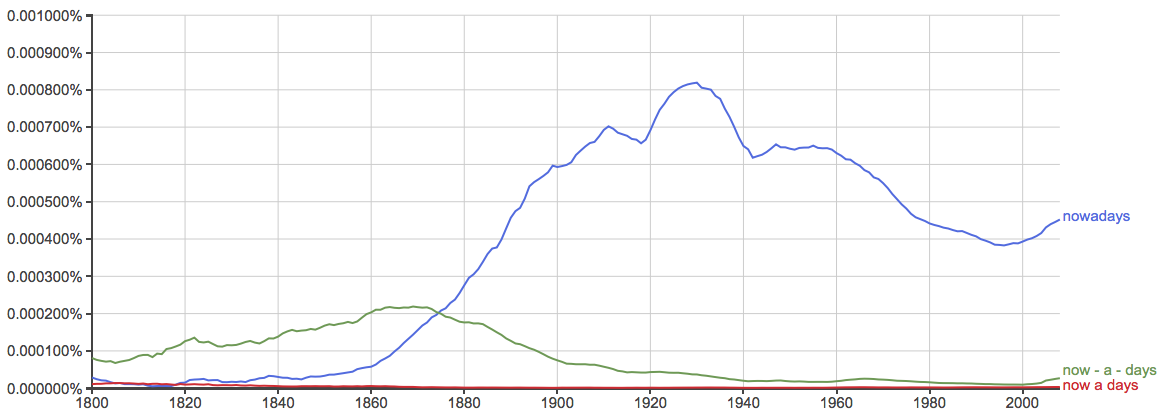As languages age, they evolve to match usage trends and broad cultural shifts. At the word level, this sometimes means that spelling changes, or that phrases containing multiple words are condensed into a single word, often through compounding.
In one prominent example, the word nowadays was originally a three-word phrase, now a dayes, from the 14th century.
Today, however, it almost always appears as a single word. But is this shortening a mistake, or does it represent the healthy and necessarily evolution of English? Continue reading to discover whether you should use nowadays or stick with now a days.
What is the Difference Between Nowadays and Now a Days?
In this post, I will compare nowadays vs. now a days. I will outline when it is appropriate to use each spelling. Plus, I will demonstrate the use of a memory tool that you can use to help you remember whether to use nowadays or now a days in your own writing.
When to Use Nowadays
 What does nowadays mean? Nowadays is an adverb that means at the present time. Nowadays is a synonym of its fellow adverbs, presently and currently.
What does nowadays mean? Nowadays is an adverb that means at the present time. Nowadays is a synonym of its fellow adverbs, presently and currently.
See the sentences below for examples,
- Nowadays, people don’t build cars like the ’63 Corvette coupe anymore.
- Nowadays, the domination of the MacBook Pro in an increasingly competitive ultrabook space is no longer taken as a given.
- My perspective on world affairs is quite different nowadays than it was even a few short years ago.
- These should be graded outward and downward from the swamp’s wettest areas. Then lay drainage “tiles”—nowadays large sections of plastic pipe are used—in the trenches. –The Wall Street Journal
When to Use Now a Days
 What does now a days mean? Now a days represents an inferior variant of the word nowadays.
What does now a days mean? Now a days represents an inferior variant of the word nowadays.
According to the Oxford English Dictionary, the first recorded use of this word was in 1362. It originates from a Middle English phrase that was originally written as three words, forming nou A dayes.
In its first 100 or so years of use, a few spellings existed, including nou A dayes, nou adaies, now a dayes, nowadayes, etc. After some time, a hyphenated version that more resembles the phrase we see today began to gain ground: now-a-days.
Today, however, the term is invariably combined into a single word without spaces. The following graph shows the frequency of nowadays vs. now a days vs. now-a-days in contemporary English.

Of course, this graph only looks at published English sources since the year 1800, so it is not scientific, or exhaustively accurate. It still clearly shows that the single word nowadays is the standard variant of this phrase.
Trick to Remember the Difference
 In modern written English, you should always choose nowadays. Despite the word’s origins as a three-word phrase, today, almost all writers use the single-word form, and popular style guides including The AP Stylebook advise their writers to use the single word variant, without hyphens. To revert to the original variant would be needlessly distracting to your readers.
In modern written English, you should always choose nowadays. Despite the word’s origins as a three-word phrase, today, almost all writers use the single-word form, and popular style guides including The AP Stylebook advise their writers to use the single word variant, without hyphens. To revert to the original variant would be needlessly distracting to your readers.
For a reminder that nowadays is the correct version, remember that its synonyms currently and presently are also single words. This should make it easy for you to keep these words straight in your mind.
Summary
Is it nowadays or now a days? The adverb nowadays used to be a three-word phrase several centuries ago, but at least since 1880, writers have shortened it into a single word.
- The single word nowadays is the favored spelling in Modern English.
- Now a days is no longer considered correct.
- The hyphenated now-a-days has also fallen out of use.
Since its synonyms currently and presently are also a single word, it should be no trouble to remember to choose nowadays over now a days.
Remember, you can always check this site for a quick refresher, or any time you have questions about writing and language.
Contents
